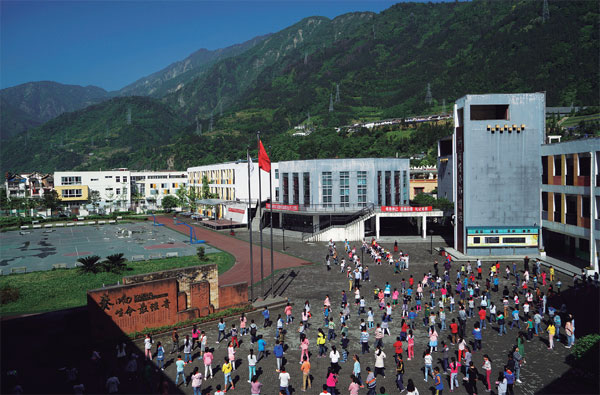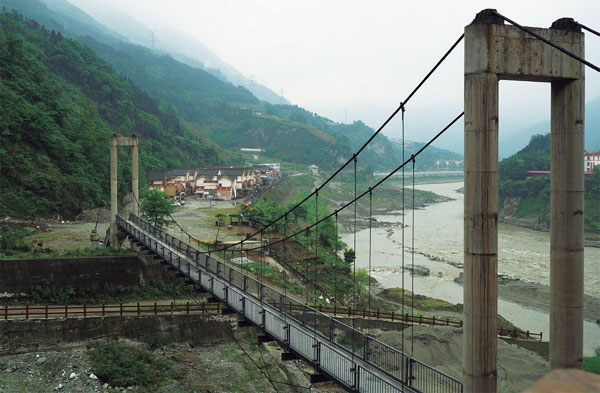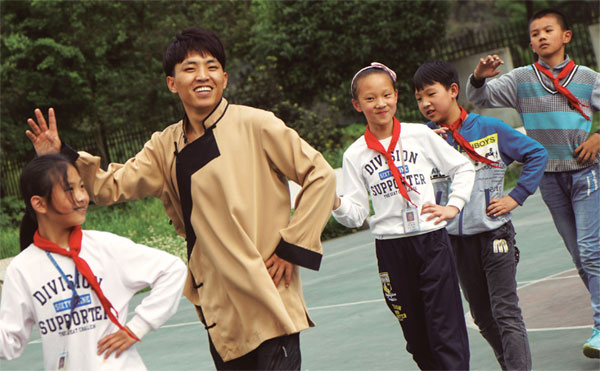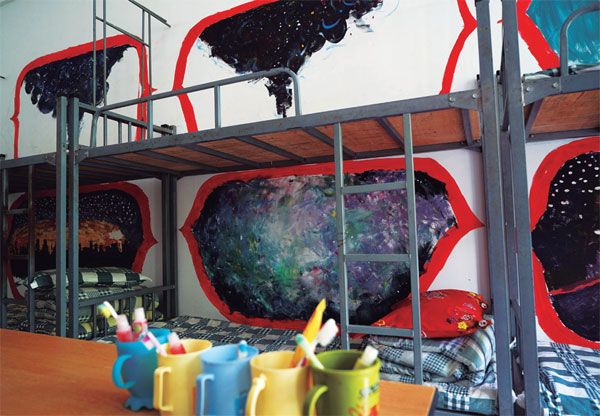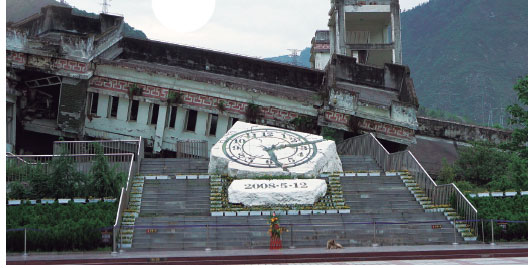Eight years after: Closing the door on the past
Updated: 2016-05-17 08:09
By Sylvia Chang(HK Edition)
|
|||||||
As social workers led by Hong Kong Polytechnic University who ran a psychological support service in quake-affected Sichuan since May 2008 prepare to wind up, they share their stories of trials and triumphs with Sylvia Chang in Yingxiu town, Wenchuan county.
'Flowers are blooming in Yingxiu," goes the song. "Birds are flying. The place is full of vigor and hope" the children sing, led by teachers and social workers. It's a song of hope and remembrance, a way the town tries to close the door on the past - that awful day, May 12, 2008, when the devastating 8-magnitude Wenchuan earthquake struck.
In the village of Zhangjiaping, in Yingxiu town of Sichuan, the epicenter of the earthquake, people seem to be in tacit agreement not to talk about the earthquake, but look with hope to the future. But Dong Chengxiang will never forget. The earthquake struck at 2:28 pm. Of the 12,000 residents of Yingxiu, more than 9,000 died. Dong's two daughters, aged 13 and 11, were in school at the time. They died under the rubble, when their shabbily built school crumbled from the shock. Zhang hasn't set foot in a school ever since.
The survivors have moved on. Dong has another daughter. She's now 6.
As the eighth anniversary of the tremor is commemorated this month, the students, their teachers and hundreds of others gathered to sing their song. Yingxiu, which translates literally as "reflected beauty", came to say goodbye to an eight-year program, and the social workers who helped rebuild their lives. When the song ended, there were tears - memories of the loved ones lost as well as tears of hope.
The scholars of Hong Kong Polytechnic University (PolyU) who ran the program had met with students, parents, families, and the community at large, to help the people heal psychologically and rebuild the social fabric of the community.
The program grew deep roots in the town. Social scientists say the efforts have become a model of effective reconstruction after a disaster. It's a model that grew over time and one that will apply in other disaster-struck places in China and overseas.
"I learnt to drink in the first month I arrived here," teased the program leader, Timothy Sim Boon-wee, associate professor in the Department of Applied Social Sciences at PolyU.
Maintaining a "professional distance" with clients is a standard for social workers, said the Singaporean native. Eating with clients is not permitted and drinking alcohol is strictly out of bounds. Sim, however, broke the rules, saying that it was essential in this remote Chinese village where the different ethnicities keep to their traditional ways of living.
"To build trust with local people and to evolve within their cultures were the first steps of professional intervention (in terms of psychological and social recovery) after the earthquake," Sim explained.
Groups of psychologists flooded into the affected places in the weeks following the quake, to begin the work of healing. Other groups had come to do surveys, but offered little or nothing by way of help. They left after collecting data. Survivors would say to each other, "Be mindful of fire, theft and psychotherapy".
Sim and his team started organizing activities for children who had suffered loss. Through these activities the team was able to observe how children were dealing with the tragedy, identify their topmost needs and then set to work, case by case.
Bottom-up involvement
Apart from this bottom-up involvement, as Sim described it, the team also initiated top-down activities by coordinating government officials and local villagers, helping to resolve occasional clashes, mainly caused by dissatisfaction on disaster management.
"Parents demanded explanations from the government on why their children died. Some condemned the government for ignorance on disaster prevention and negligence in carrying out proper evacuation when the quake occurred," recalled Dong Xuefeng, the current principal of the Yingxiu Primary School. He lost his wife and only son, who was 11, in the quake.
At Yingxiu Primary School, reduced to rubble during the quake, 222 students out of 473 died, according to government figures. Many teachers lost their children and spouses.
The town's grief sometimes turned to anger, towards people including government officials who came to distribute disaster relief allowances. "Officials from the county's Education Bureau were punched," recalled Kang Jin, a social worker who served the program during the first three years after the earthquake.
Social workers did what they could, accompanying teachers to each family home to comfort the parents, Kang said. He had just graduated from college at the time.
"Most of the time we just sat there listening and trying to show sympathy towards parents. We tried to direct them with planning for the future," said Kang. The teachers needed consoling too. Sometimes parents lashed out and condemned the teachers for failing to save their children.
Dance therapy
The new Zhangjiaping village is located at the foot of a mountain. The Minjiang River, a tributary of the upper Yangtze River, rushes by on the other side. In July 2013, the village was beset by new trials, when rainstorms, followed by landslides, struck the village, leaving about 250 villagers stranded on an isolated island.
In the years since Dong Chengxiang lost her two daughters, she often wakes up at night, stricken by nightmares, when she can hear her daughters' voices calling for her. The voices tear at her heart.
The team of social workers from PolyU found many women like Dong Chengxiang in Zhangjiaping village were living in fear. In this typical village of China, most men and young people have left to work in cities. Women were left at home, to take care of children and the elderly.
"Banality had worn down the women's mental resilience when it came the time to face the disaster. Conversations among them about daily trifles often led to arguments that they didn't know how to deal with," social worker Zhao Xiaokang recalled his first meetings with women in the village.
Zhao, 26, born in a village of the Qiang ethnic group, is a natural dancer. At a performance in Zhangjiaping, he danced the Guozhuang, a traditional dance form of Qiang and Tibetan ethnic groups.
The women of the village were enthralled, leading Zhao to start dance classes for them every week.
"Dancing brought us closer," said Dong Chengxiang, adding that members in the group also bonded and began helping each other to deal with daily difficulties and share their thoughts on disaster prevention.
Dong Chengxiang recalled the time when a dance group member's child scalded her foot in a careless accident. The wound needed to be cleaned every two hours. Members of the dance group volunteered. They took turns visiting the hospital to take care of the child, round the clock.
The incident inspired Dong Chengxiang to join the social work program in Yingxiu and start helping to organize events. "Before 2008, people in the village had no idea what a social worker was for. Now we all know," she said.
Eight-year social work programs are rare in China, especially those seen as providing great value to individual members of the community. Sim of PolyU pointed out sufficient funding and less cumbersome procedures were important for maintaining the program, and support was necessary to ensure that social workers had the space and freedom to work to full capacity. As of December 2015, the project had received funding of about HK$7.4 million, according to Sim.
The community has changed over eight years. The wounds of the people are starting to heal. Nobody can really say whether it was time or service offered by social workers that helped more. As Dong Chengxiang tweeted on her WeChat messaging app, "These (social workers) have become as close as family members."
School principal Dong Xuefeng is considering keeping the social work station at his school functional, to carry out other social programs. Dong Chengxiang would like to join, if it happened. "I have seen the value of social work, and I'm willing to do something like that," she said.
Contact the writer at sylvia@chinadailyhk.com
|
Dong Chengxiang at the gate of Yingxiu Primary School in Wenchuan county. She hasn't set foot inside a school since her two daughters died under the collapsed old school building. |
|
Dong Chengxiang's 6-year-old daughter at their home in the new Zhangjiaping village built after the earthquake. |
|
|
|
Dong Chengxiang looks on at the remains of the previous Zhangjiaping village which was totally destroyed in the earthquake and has since been rebuilt. photos by Sylvia Chang / China Daily |
|
|
|
|
|
Social worker Zhang Xiaokang (second from left) does a Guozhuang dance with students in Yingxiu Primary School. |
|
|
|
|
|
|
(HK Edition 05/17/2016 page9)




